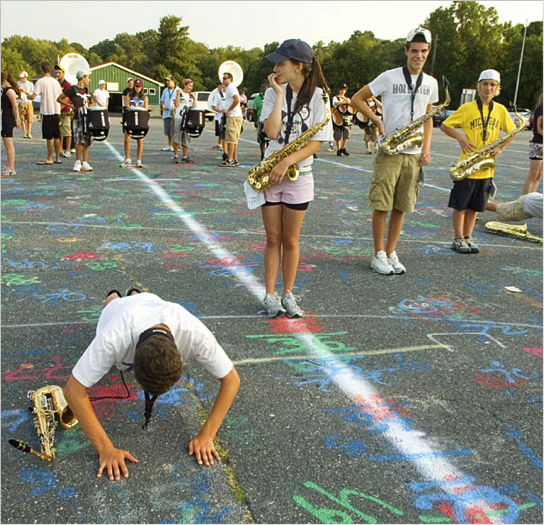If you’ve been on a marching band field, you’ve probably heard of using push-ups as “negative reinforcement” for making a mistake during rehearsal. No, I am not about to go into detail about negative and positive reinforcement usage with adolescents and youth; that would be the job of another healthcare professional. Instead, I am going to explain to you why having marching band students repeatedly perform push-ups is wasting your program’s time and energy as well as what other alternatives there are.
The Purpose of The Push-up
Push-ups are an excellent way to strengthen the pectoral muscles, the triceps, and the core musculature when performed correctly. Are all three of these muscle groups vital to the marching activity? No, and suggesting that two out of the three are priorities in the marching activity would be generous. What do I mean?
Muscle #1: Pectoralis Major
First, let’s look at pectoralis major. This muscle group has two sections, referred to as heads: the clavicular head (which attaches to the collar bone) and the sternocostal head (attaches to the sternum and ribs). The clavicular head is responsible for flexing the humerus (arm bone) forward. When you hold your horn in the playing position this muscle is active isometrically, meaning the muscle is contracted even though your arm is stationary. As you can see in Figure 1, this is a fairly small portion of the pec major.
The sternal head, however, might as well be out to lunch while you’re at band practice. Its role is to extend the humerus backwards, which is actually the opposite of the clavicular head and a motion that is fairly useless in the marching activity. It also works to internally rotate and adduct the humerus, motions which play minor roles in holding your horn in a playing position. In fact, you need your EXTERNAL rotators and ABDUCTORS to be isometrically firing while holding up your horn, so having the sternal head active would inhibit the muscles that you want to be working for you.
Muscle #2: Triceps
The triceps receive a strong workload when performing push-ups due to their action of extending (straightening) the elbow. The irony of strengthening the triceps for marching band is that no horn or percussion members play their instrument with their arms straight. This muscle would be most relevant in color guard members performing the movements required for their work.
Instead, the muscle that is active while holding your horn is the biceps muscle. By being an elbow flexor, this muscle does the opposite motion of the triceps. It is active isometrically while the horn is in the playing position.
Muscle #3: The Core
Finally, here is a muscle group used in push-ups that can apply to marching. When performed correctly, the transverse abdominis—a key stabilizing core muscle—should be active during the push-up. This muscle is crucial for developing trunk stability while marching and preventing back pain. (For more on this topic, see our previous blogpost.)
Alternatives
While push-ups may be popular for the simple fact that they can be performed quickly, they are not the most efficient exercise for marching band. Here are two exercises that can be performed just as easily that target more specific muscles for marching.
Squats
Squats target all the lower body muscles that you need to improve your marching technique. Squats activate the quadriceps, glutes, and hamstrings all in one movement. If you add a jump to the end of it, you can activate the calf muscles as well.
Shoulder Press
The shoulder press is more specific to targeting the deltoids and clavicular portion of pectoralis major, making it an upgrade from the push-up. Plus, a member can perform this exercise while holding his or her instrument as resistance.
Always Ask Why
Push-ups are not a bad exercise. However, it is vital to always ask yourself why you are doing what you are doing. For physical conditioning, push-ups are great. However, for developing muscles specifically for marching, I believe there are more efficient options.
References:
Figure 1: Hirshey G. A Lot Like Boot Camp, but With Horns and Drums. The New York Times. http://www.nytimes.com/2008/09/14/nyregion/nyregionspecial2/14colct.html. Published September 13, 2008. Accessed June 19, 2017.
Figure 2: Muscles of the Pectoral Region. TeachMeAnatomy. http://teachmeanatomy.info/upper-limb/muscles/pectoral-region/. Published March 24, 2017. Accessed June 19, 2017.
082 The Origin, Insertion, and Action of Pectoralis Major. Interactive Biology, with Leslie Samuel. http://www.interactive-biology.com/4276/082-the-origin-insertion-and-action-of-pectoralis-major/. Published January 9, 2016. Accessed June 19

